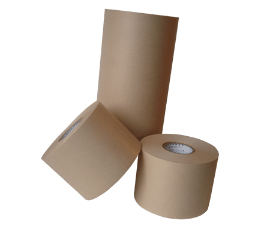Capacitor paper is an insulating paper specially designed for making paper capacitors. For web. The paper is even and tight. No holes. Thin as cicada wings. The thickness is 4-10 μm. Has a high mechanical strength. Good air permeability, electrolyte absorption performance and chemical purity. Copper and iron ions, chloride and ash content are extremely low. The pH is close to neutral. Excellent physical and electrical properties. There are specific requirements for breakdown voltage and conductive particles. Using unbleached sulfate softwood pulp as raw material, without any auxiliary materials, after high-viscosity beating, it is made on a special long-mesh tissue machine and super calendered. The production water must be treated by ion exchange method to make the content of copper, iron and chloride ion extremely low.
 Electrolytic capacitor paper (also called electrolytic paper) is one of the three key materials that make up aluminum electrolytic capacitors. It acts as an adsorption carrier for the electrolyte, and together with the electrolyte constitutes the cathode of an aluminum electrolytic capacitor, and at the same time plays the role of isolating the two-pole foil, also known as isolation paper.
Electrolytic capacitor paper (also called electrolytic paper) is one of the three key materials that make up aluminum electrolytic capacitors. It acts as an adsorption carrier for the electrolyte, and together with the electrolyte constitutes the cathode of an aluminum electrolytic capacitor, and at the same time plays the role of isolating the two-pole foil, also known as isolation paper.
In terms of industry classification, electrolytic paper is both a specialty paper and an electronic component material. Therefore, electrolytic paper not only needs to have harsh physical requirements and extremely high chemical purity, but also has excellent electrical properties. Its production The process requires not only papermaking technology, but also electrical, basic chemistry, polymer material chemistry, pure water preparation and other technologies, which can be said to be a technology-intensive product. Due to the special requirements of electrolytic capacitor paper, the production equipment of electrolytic capacitor paper is made of special materials. In order to meet the production of different varieties, different performances, and different raw materials, a variety of electrolytic capacitor paper production equipment is required. Only the papermaking equipment has rotary screen-long net composite paper machine, rotary screen-special net composite paper machine Net multi-cylinder paper machine, multi-round net paper machine, oblique net paper machine, etc.
Paper capacitors, also known as rolled capacitors or film/foil capacitors, are a type of capacitor that uses paper as the dielectric material. They consist of two metal foils, typically aluminum, separated by a paper dielectric. The metal foils act as the capacitor plates, and the paper dielectric provides insulation between them.
In paper capacitors, the paper serves as the dielectric material, providing electrical insulation between the capacitor plates and allowing the storage and release of electrical charge. The role of paper in paper capacitors can be summarized as follows:
- Dielectric Material: The primary function of the paper in paper capacitors is to act as the dielectric. The dielectric material is an insulator that separates the conductive plates of the capacitor, preventing direct electrical contact between them. Paper has good insulating properties, allowing it to withstand high voltages and provide effective insulation in the capacitor.
- Capacitance: The paper in paper capacitors determines the capacitance value of the capacitor. The surface area of the paper, its thickness, and the distance between the plates influence the capacitance. By varying these factors, manufacturers can produce paper capacitors with different capacitance values to suit various applications.
- Mechanical Support: Paper provides mechanical support within the capacitor, holding the conductive plates in place and maintaining the proper spacing between them. It helps prevent the plates from coming into direct contact, which could lead to short circuits and a loss of capacitance.
- Heat Dissipation: Paper also assists in dissipating heat generated during the operation of the capacitor. It provides a pathway for the transfer of heat away from the conductive plates, helping to maintain stable operating temperatures within the capacitor.
It’s important to note that while paper capacitors were widely used in the past, they have been largely replaced by other capacitor technologies, such as film capacitors and ceramic capacitors, which offer improved performance, smaller size, and higher capacitance values.




